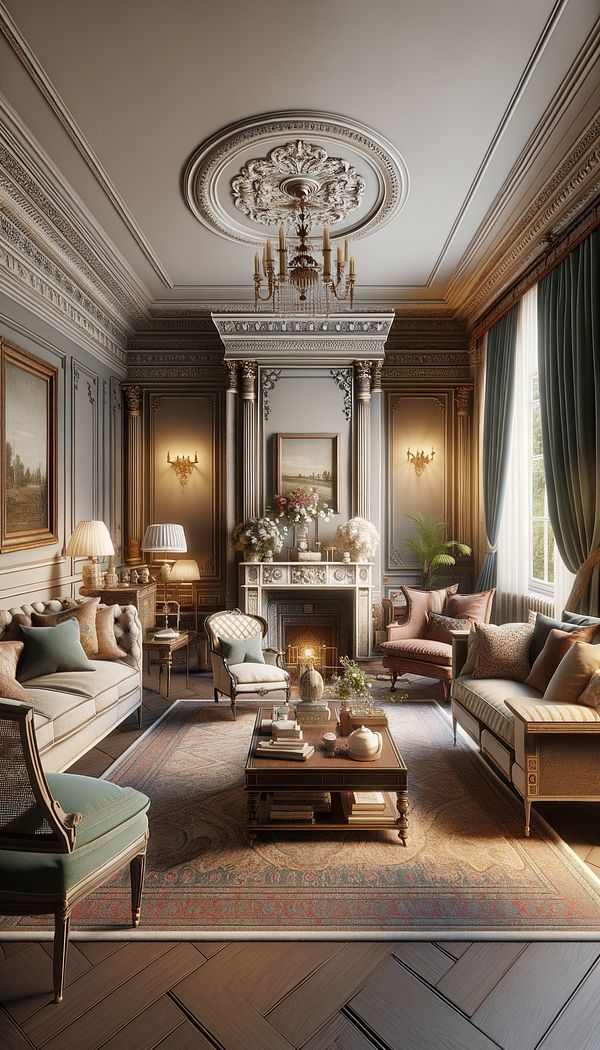What is Traditional?
Traditional interior design is a timeless style that emphasizes classic, symmetrical arrangements and rich details.
Description
Traditional interior design refers to a style that is rooted in classic European sensibilities. It is characterized by its attention to detail, use of rich fabrics, and sophisticated color palette. Traditional spaces often incorporate a mix of antique and reproduction furniture pieces, emphasizing symmetry and order. Architectural elements like crown moldings, wood paneling, and intricate fireplaces play a significant role in adding character and depth to traditional designs.
The color scheme in traditional interiors tends towards muted, neutral tones, accented with deep, rich colors like burgundy, navy, and forest green. Fabrics used in traditional settings frequently include luxurious materials such as silk, velvet, and brocade, often featuring classic patterns like florals, plaids, and stripes. Decorative accents, including lamps, rugs, and artwork, are carefully chosen to complement the overall aesthetic, often adding a personal touch that reflects the history and interests of the inhabitants.
Unlike more minimalist styles, traditional design encourages the display of accessories and collections, resulting in spaces that feel cozy and lived-in. This does not mean, however, that traditional interiors are cluttered; rather, items are arranged in a deliberate and balanced manner. Lighting in traditional design typically includes a mix of table and floor lamps, sconces, and chandeliers, contributing to the warm, inviting ambiance of the space.
Usage
Traditional interior design can be seen in various settings, from stately homes and elegant apartments to cozy country cottages and classic hospitality venues. It's particularly favored by those who appreciate timeless elegance and a sense of history in their living spaces.
FAQs
-
How does traditional interior design differ from modern design?
Traditional interior design differs from modern design in its emphasis on detail, historical elements, and rich textures. While modern design often focuses on minimalism, clean lines, and functional simplicity, traditional design celebrates ornate details, symmetrical arrangements, and a rich mix of textures and patterns.
-
Can traditional and modern elements be mixed in one space?
Yes, traditional and modern elements can be blended to create a transitional style that combines the best of both worlds. This approach allows for a timeless, sophisticated space that feels both comfortable and contemporary.
-
Is traditional interior design expensive?
Creating a traditional interior can vary in cost, depending on the quality of materials and furnishings chosen. While incorporating authentic antiques and high-quality fabrics can be costly, there are also affordable ways to achieve a traditional look with reproduction furniture and budget-friendly textiles.
Practical Application
To successfully incorporate traditional design into your home, focus on symmetry, classic furniture pieces, and a muted color palette accented with rich colors. Mix antique or reproduction furniture with luxurious textiles, and don't shy away from displaying personal collections and artwork to add character and warmth to your space. Paying attention to architectural details and choosing appropriate lighting fixtures will enhance the overall traditional aesthetic.
-
Design Styles478 articles
-
Furniture Types599 articles
-
Decorative Objects240 articles
-
Materials & Textiles360 articles
-
Color & Patterns154 articles
-
Spiral LegA spiral leg is a furniture leg characterized by its twisted or helical shape.
-
Bungalow StyleBungalow Style refers to a compact, single-story house design with distinct architectural features.
-
WhitewashingWhitewashing is a painting technique that uses diluted paint to create a translucent finish.
-
DovetailDovetail is a type of interlocking joinery technique used in woodworking.
-
Modern StyleModern style in interior design refers to a design movement that emphasizes simplicity and function, incorporating sleek lines and a minimalist aesthetic.
